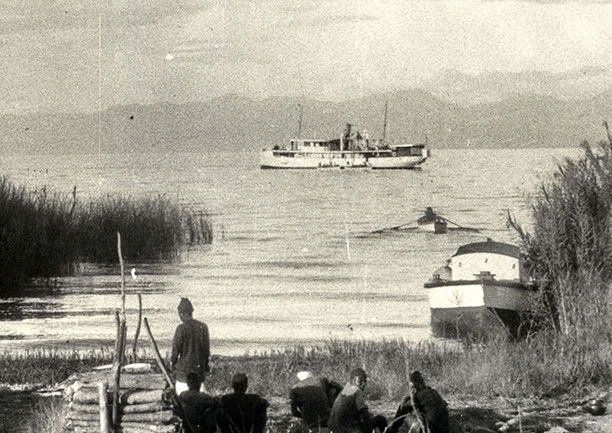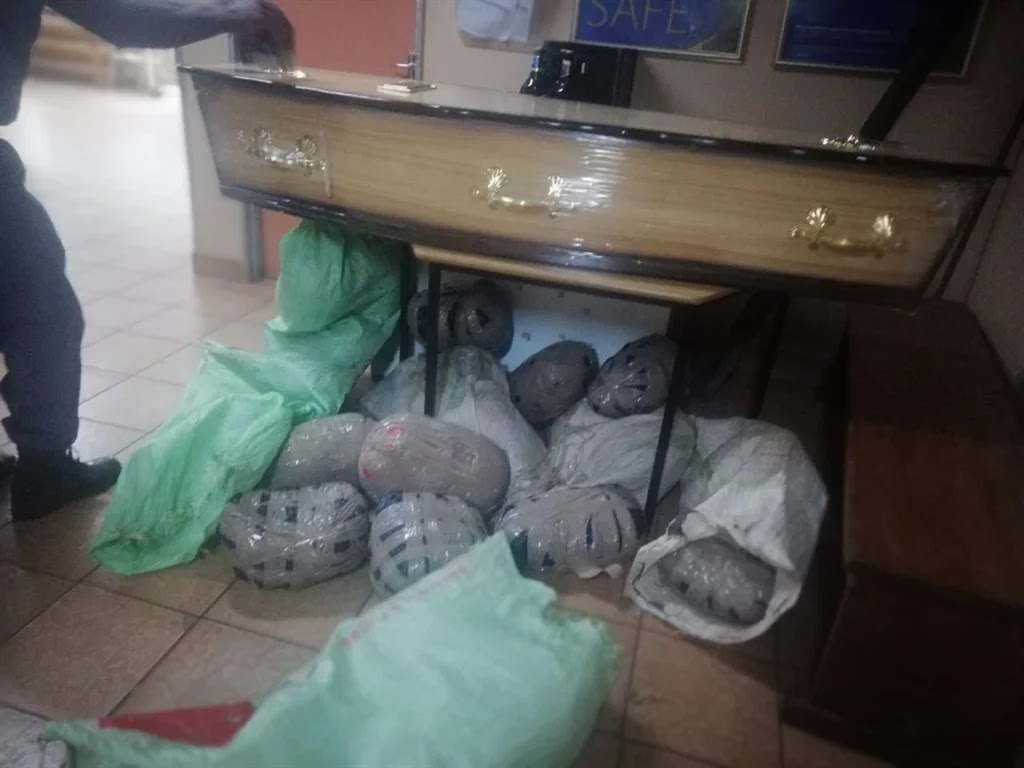The opening naval battle of the First World War took place not in the North Sea but in Central Africa in August 1914. It would change the course of the African conflict in Britain’s favour, says Janie Hampton.
 The wooding station on Lake Nyasa used by SS Chauncy Maples, 1914. Photo by the authorFacing each other across Lake Nyasa (now Lake Malawi) were British East Africa (Malawi) and German East Africa (Tanzania). Their navies each had one gunboat. The German SS Hermann von Wissmann was named after the explorer and anti-slaver. Like her British counterpart, she was built in Europe and shipped in pieces to East Africa and up the Zambezi River. From there the sections were carried by porters to Fort Johnston (now Mangochi) at the south end of the lake, where they were reconstructed. In 1893 the hull of the von Wissmann was towed by a British gunboat up the lake to the German port of New Landeburg for fitting out.
The wooding station on Lake Nyasa used by SS Chauncy Maples, 1914. Photo by the authorFacing each other across Lake Nyasa (now Lake Malawi) were British East Africa (Malawi) and German East Africa (Tanzania). Their navies each had one gunboat. The German SS Hermann von Wissmann was named after the explorer and anti-slaver. Like her British counterpart, she was built in Europe and shipped in pieces to East Africa and up the Zambezi River. From there the sections were carried by porters to Fort Johnston (now Mangochi) at the south end of the lake, where they were reconstructed. In 1893 the hull of the von Wissmann was towed by a British gunboat up the lake to the German port of New Landeburg for fitting out.
The larger HMS Gwendolen was a steamship, named after Lady Gwendolen Gascoyne-Cecil, daughter of the 3rd Marquess of Salisbury. In 1899 Miss Helen Caddick of West Bromwich visited Fort Johnston and admired the red corrugated iron-roofed shops and the nearly finished ship. ‘The noise made by the workmen hammering on the iron plates reminded one of the Clyde,’ she commented.
For over a decade Commander Edmund Rhoades and Kapitan Berndt patrolled the lake for slavers and met on each other’s ships. They even practised mock battles, trying to sneak up on one another.
On August 4th, 1914 the British Governor of the Protectorate of Central Africa, Sir George Smith, was informed by telegram that war had been declared between Britain and Germany. He immediately cabled the District Commissioner, Frank Webb, in the northern lakeside province of Karonga. They both knew that the 30 African policemen and nine Europeans stationed there – none of them soldiers – could not hold back the 2,000 German askaris (local soldiers) assembled on the border. Control of Nyasaland was vital to both sides: whoever ruled the 350-mile lake also controlled the supply lines for food, fuel and minerals to and from Rhodesia and South Africa.
The nearest British troops, the King’s African Rifles (KAR), were over 400 miles south and the only route to Karonga was via the lake. On water they risked attack by the von Wissmann, which, unlike the Gwendolen, had electric spotlights and a gun turret. The Gwendolen was fitted with a six-pounder Hotchkiss, but it had never been used and nobody knew how to fire it. The shells were eventually found in a box labelled ‘Spares’ and Jock, a Scottish shop assistant in Fort Johnston, was enlisted, after he bragged that he had been a volunteer seaman-gunner in Glasgow, though he was not sure how much he remembered. The Gwendolen set sail with five Britons, 30 African stokers and 25 KAR askaris commanded by 2nd Lieutenant Beaumont, an official in the Public Works Department, who wore a monocle and was known as ‘Champagne Charlie’.
After four days the ship reached the British base at Nkhata Bay on the western shore. Tonga fishermen reported having seen the von Wissmann three weeks earlier, pulled up on a slipway in the German harbour of Sphinxhaven – so called because a rocky outcrop nearby looked vaguely like an Egyptian sphinx. She might still be under repair, or waiting to surprise them from one of many inlets and bays.
On the evening of August 13th the Gwendolen set off to cross the lake. Rhoades hoped that the early mist would shield the ship from view but the 14th dawned bright. Dr Sanderson, the temporary ship’s surgeon, had set up a casualty station by erecting his camp-bed below deck and piling sacks of rice against the bulkheads. Gunner Jock was ready at the Hotchkiss, with the funnel behind him shielded from gunfire by steel plates.
As the Gwendolen sailed into Sphinxhaven bay, a swell caught the ship broadside on and she began to roll. At that moment the white-hulled von Wissmann came into view, hauled up on the beach. At 2,000 yards Rhoades ordered Jock to open fire. The ammunition was over 15-years-old and the first shell was a dud. The next few landed way beyond their target, which at least scared the African villagers away. Finally Jock landed a direct hit on the von Wissmann, sending up a shower of splinters. At this moment a small boat containing a stout European clad in vest and shorts started rowing towards them from the beach. Rhoades ordered ‘Cease Fire’. Its furious occupant rose to his feet and shook both fists above his head. ‘Gott for damn, Rhoades, vos you drunk?’ he exclaimed.
‘Afraid not old chap,’ called Rhoades. ‘Our countries are at war. Best thing you can do is surrender.’
‘Surrender be hanged. Come and have a drink.’ A second shot took away von Wissmann’s funnel. Rhoades informed Berndt he was now his prisoner.
‘One could see his anger turn to horror’, recalled Sanderson. ‘He seemed to shrivel and allowed Rhoades to usher him into a cabin without a word. We all felt very sorry for him.’
Champagne Charlie and his askaris searched the harbour and found a German engineer in a grass shack hiding under a bed. He, too, was taken prisoner. A Royal Navy engineer called Haynes removed the gun and the ship’s bell from the von Wissmann, while the doctor, with no wounded to tend to, unscrewed the clock from the chartroom.
That afternoon Rhoades sent a coded telegram from Nkhata Bay: ‘Wissmann taken completely by surprise.’ The following day British newspapers reported ‘Naval Victory on Lake Nyasa.’
The same day Webb received a telegram from the District Officer or Bezirksamtmann at Neaulaughgeuburg on the German side of the border:
I am not clear whether England is at war with Germany or not. But I understand you are mobilising your forces and are even distributing breachloaders to the Natives on our border. If you wish to attack our province I must courteously remark that we are prepared to greet you in a somewhat unfriendly fashion. The position decidedly needs clearing up and therefore I beg you most politely and urgently to let me have a clear answer.
Webb replied: ‘War has broken out between Great Britain and Germany. Our Natives on the frontier are not being armed as alleged and HM’s government would deprecate in the circumstances of the African Colonies the employment of any other disciplined troops.’ As soon as the District Officer heard this, German troops began to march south towards Karonga.
With the von Wissmann out of action, it was now safe to transport the several hundred British troops up the lake to repel them. From Karonga the column made its way north, avoiding the road. Unwittingly, the two armies passed each other less than a mile apart. When the British realised, they doubled back and attacked the superior German force from the rear. With this victory on September 9th the British saved Karonga and captured two four-pounder machine guns. The guns were mounted on SS Chauncy Maples, which had recently been commandeered from the Universities Mission to Central Africa. Designed in 1895 by Isambard Brunel’s son, Henry, she had been built in Glasgow and shipped in pieces to Lake Nyasa. Chauncy Maples had been the only link between remote lakeside mission stations and functioned as a floating church, a post office and a clinic. Now she was the second British gunboat.
The steam ships were powered by wood, which was bartered for calico from ‘wooding stations’ around the lake, at one yard of cloth for a cubic yard of wood. The boilers required that amount every hour and the ships could carry only enough fuel for a few days. The process of bartering and loading wood could take all day. The firewood had to be guarded: in 1915 a man from Portuguese East Africa was arrested carrying 120 sticks of dynamite, fuses, a brace and bit and letters in German to a ‘Portuguese Mahommedan’, suggesting the explosives be used to destroy British lives and property. The brace and bit indicated that the plan was to conceal the dynamite inside fuel logs.
In March 1915 the Lake Nyasa fleet, now numbering three gunships, two missionary steam ships, a trader’s paddle steamer and two sail boats, came under the command of Lieutenant George Dennistoun, a New Zealander. Dennistoun belonged to an adventurous family; his brother Jim was a mountaineer who had volunteered to be in charge of the mules on Captain Scott’s ill-fated 1911-12 Antarctic expedition. Dennistoun, recently married, arrived in London via Tahiti and Egypt. Giving him his orders, Admiral Sir Henry Bradwardine Jackson said: ‘What a chance for a youngster! Wish I was going myself. Bring me back a kudu’s head. You’ll be back in six months and we’ll promote you to Commander.’ Dennistoun bought food on tick at the Army & Navy Stores and gathered up two sub-lieutenants. Their journey via the Cape and up the Zambesi to Nyasaland took over three months.
Within a month of Dennistoun’s arrival, local fishermen informed the British that the von Wissmann had been repaired and would soon set out to hunt down the Gwendolen. Dennistoun’s orders were to overcome any resistance, secure the bay and either capture the von Wissmann or blow her up. The 1915 log book of Chauncy Maples describes the events of May 30th. Before dawn, in pouring rain, KAR troops disembarked three miles south of Sphinxhaven, guided by Jimmy Sutherland, an elephant hunter. At first light the Gwendolen and the Chauncy Maples steamed slowly into the bay and were fired on from the shore. The KAR troops charged up the slope towards the German trenches. ‘They were found to be deserted’, recalled Dennistoun, ‘except for a German dachshund which we had on Chauncy Maples for some time afterwards.’
Once the military gave the all-clear, Engineer Haynes went ashore to examine the von Wissmann. Several hull plates were damaged and Dennistoun decided that, with German troops in the vicinity, there was not enough time to repair the ship. Haynes replaced the fishing nets he found in the hull with explosives. At noon the Gwendolen opened fire and the von Wissmann blew up. Just as the last of the troops clambered back on board, the Germans returned and retaliated. ‘Two Maxims and troops opened fire from deck of “CM”,’ reported the logbook. ‘Gwendolen shelling. Took all [life] boats in safely without casualties. Crew behaved admirably under heavy fire from Germans on shore.’ The British had got out just in time.
A year later Dennistoun learned that once again the Germans had repaired the von Wissmann. Before dawn on April 28th, 1916 the Gwendolen and Chauncy Maples approached Sphinxhaven and dropped off askaris, who rowed silently into the dark bay. Meeting no resistance, they boarded the von Wissmann and towed her away. She was renamed HMS King George.
‘I turned our “fleet” into a sort of maritime Pickford’s Carrier service,’ wrote Dennistoun. ‘We just ran up and down the lake with men and materials. I felt I could run the Cunard Company by the time I came home. On the other hand, I did not know one end of a gun from the other end of a torpedo. But the life was pleasant and interesting.’
In addition to transporting local porters, troops and prisoners, the Chauncy Maples carried food, arms and petrol for army trucks. On two occasions the crew were injured by explosions caused by igniting petrol fumes. Other hazards included malaria and fierce storms. At the end of the war the crews of Gwendolen and Chauncy Maples succumbed to the influenza that was blighting Europe. Both ships were placed under quarantine, which was only lifted when all the men had either recovered fully or died.
Dennistoun finally left for home in late 1918 having taken no leave in over three years. HMS King George was bought by the Lake Nyasa Steamship Company and renamed Malonda (trader) as a cargo steamer. Its final owner was Mr Finlay-Bissett, a notorious poacher, who scrapped her in 1951. The same year a German missionary travelling on the Chauncy Maples revealed that when Sphinxhaven was attacked in 1915 he had been the only European present, with a mere 20 German askari under his command.
HMS Gwendolen was retired from the Royal Navy in 1940 and became a passenger ferry. After she was scrapped in 1943, parts were used to repair the bulk heads of Chauncy Maples. In 1967 Chauncy Maples was refitted with a diesel engine. Currently under renovation as a mobile clinic, she is Africa’s oldest working ship and the last working vessel to have taken part in the First World War.
Commander Rhoades’ former house in Fort Johnston is now a hotel where guests may sleep in his bedroom. From the veranda there is a fine view of a roundabout, on which sits the Gwendolen’s six-pounder gun, the weapon that secured the first naval victory of the First World War.
The two cannons that the King’s African Rifles towed around Nyasaland stand outside Mangochi police station and provide a popular backdrop for wedding photos. Nearby is the former Nyasa Yacht and Gymkhana Club, which as the Lake Malawi Museum now displays the wheel, engine-room telegraph and compass from HMS Gwendolen. The significance of Rhoades’ action on August 14th, 1914 has been underestimated. If the SS Hermann von Wissmann had not been disabled in the first weeks of the war, Germany may well have won the East African campaign.





No comments! Be the first commenter?